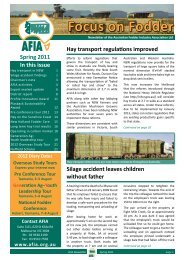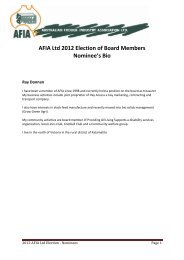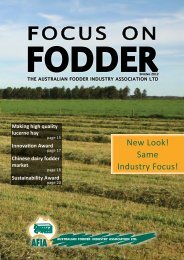AFIA - Laboratory Methods Manual - Australian Fodder Industry ...
AFIA - Laboratory Methods Manual - Australian Fodder Industry ...
AFIA - Laboratory Methods Manual - Australian Fodder Industry ...
Create successful ePaper yourself
Turn your PDF publications into a flip-book with our unique Google optimized e-Paper software.
property of <strong>AFIA</strong>. Sub-samples of the hays have been made available, together with this manual, to<br />
fodder testing laboratories affiliated with <strong>AFIA</strong>, with a specific objective of assisting laboratories to<br />
standardise their estimation of digestibility, which is a ‘property’ of fodder rather than a<br />
‘constituent’.<br />
The next important step in obtaining uniformity in fodder testing has been the introduction of ‘ring<br />
tests’. This involves sending carefully prepared sub-samples of six fodder samples to the<br />
participating laboratories on a regular basis, in order to determine the agreement between<br />
laboratories. This ‘ring test’ procedure has been and will continue to be a vital mechanism to aid<br />
quality control in laboratory testing of fodder.<br />
Additional tests to those agreed as important to the industry in 1995 have now emerged, especially<br />
in relation to fodder exports and silage. These include acid and neutral detergent fibre (ADF and<br />
NDF), measures of total or water-soluble carbohydrates, ammonia nitrogen and pH of silage. Shear<br />
energy has been added to this latest edition of the <strong>Manual</strong>.<br />
There are alternative methods possible for determining several forage quality values using more<br />
convenient equipment. The QEC decided that, where there were several alternative methods for<br />
analysing one fodder constituent, one would be referred to as the “Reference” method and given the<br />
symbol “R”, whereas the others would be designated as “Approved” methods, given the symbol<br />
“A” followed by (a..n), when there is more than one approved method. A requirement for<br />
laboratories that use “Approved” methods is for them to demonstrate that they can produce the<br />
same results obtained using the “Reference” method.<br />
Draft <strong>Methods</strong> are given the symbol “D” and may be added to this manual following consideration<br />
at the annual August meeting of the QEC. People wishing to propose new methods need to send<br />
them to the <strong>AFIA</strong> EO, Colin Peace (colin@afia.org.au), prior to July 1. Once circulated to QEC<br />
members and discussed or amended at the QEC meeting in August, proposals may become a draft<br />
method. At the subsequent August QEC meeting, a vote can be taken on any Draft Method to<br />
change it to Approved Method status, remove it from this manual, or retain it as a Draft Method.<br />
Proposed changes to any existing methods should be provided to Colin Peace in time for circulation<br />
to QEC members one month before the August meeting. As this manual is a “living” document,<br />
<strong>AFIA</strong> have decided to provide it in electronic format.<br />
Clearly, the whole issue of fodder testing methodology must be an ongoing process, as new research<br />
developments occur and new industry priorities emerge. Laboratories have to respond to these<br />
factors, but for the industry to benefit as a whole, a coordinated approach is essential. This requires<br />
the continuing dedication, cooperation, understanding and good-will of all parties, irrespective of<br />
commercial competition between laboratories and other industry participants.<br />
It is hoped that this manual will be a valuable resource for fodder testing laboratories and others<br />
with an interest in this field. Many people and organisations have contributed to the effort of<br />
producing the manual, but particular thanks are due to G&M Murphy Consulting Services, John L<br />
Black Consulting, Peter Flinn of Kelspec Services, Alan Kaiser of NSW Department of Primary<br />
Industries and RIRDC for its ongoing support. This project was funded from industry revenue that<br />
is matched by funds provided by the Federal Government via RIRDC.<br />
Acknowledgments have been included in the manual where methods have been adopted or<br />
modified from those listed in the “Forage Analyses Procedures” of the US National Forage Testing<br />
Association (1993). The note on the use of anthrone methods for carbohydrate analysis was provided<br />
by Mr A.B. Blakeney of Cereal Solutions.<br />
The Title of the <strong>Manual</strong> was changed for Edition (3) to ‘<strong>AFIA</strong> – <strong>Laboratory</strong> <strong>Methods</strong> <strong>Manual</strong>’ from<br />
‘<strong>Fodder</strong> Analyst’s <strong>Methods</strong> <strong>Manual</strong>’.<br />
iv







